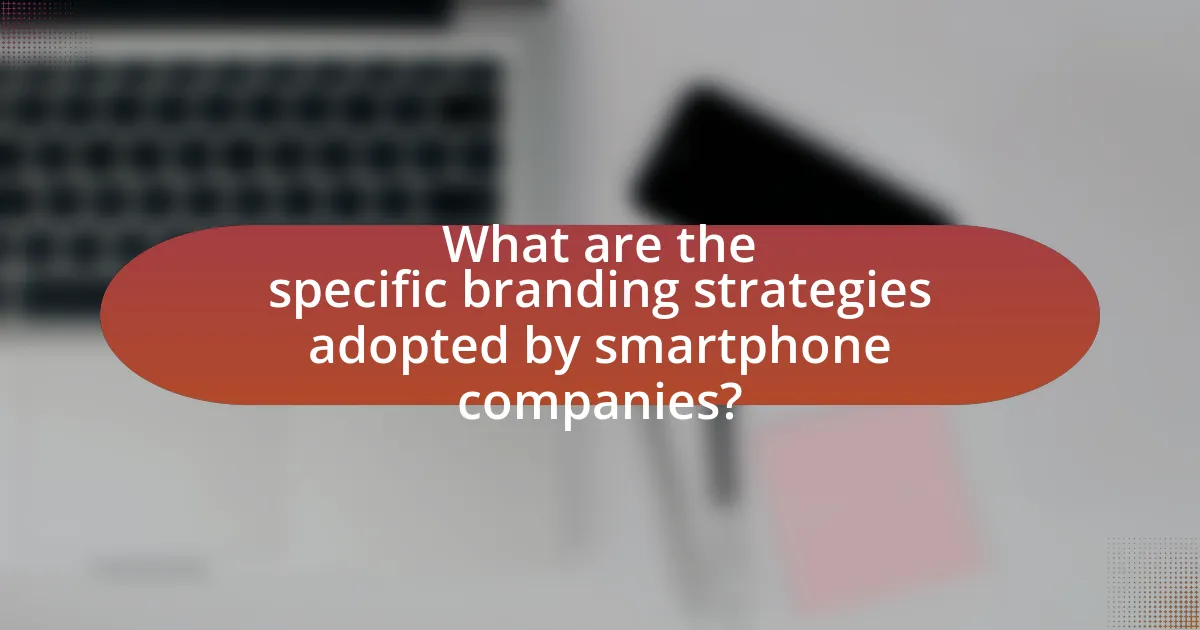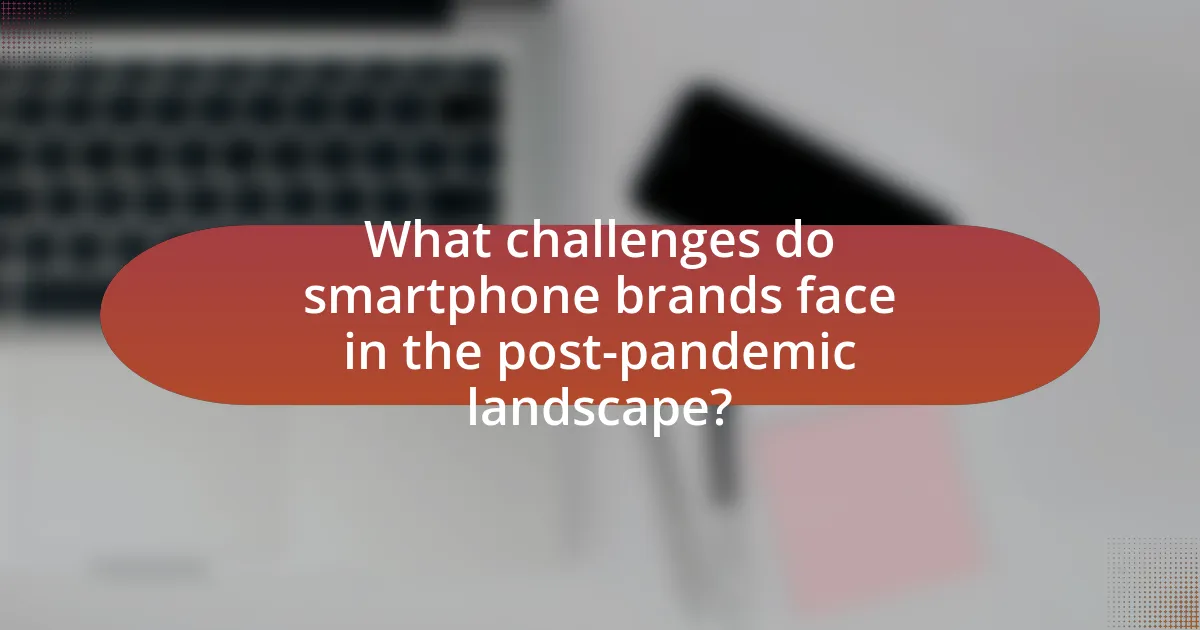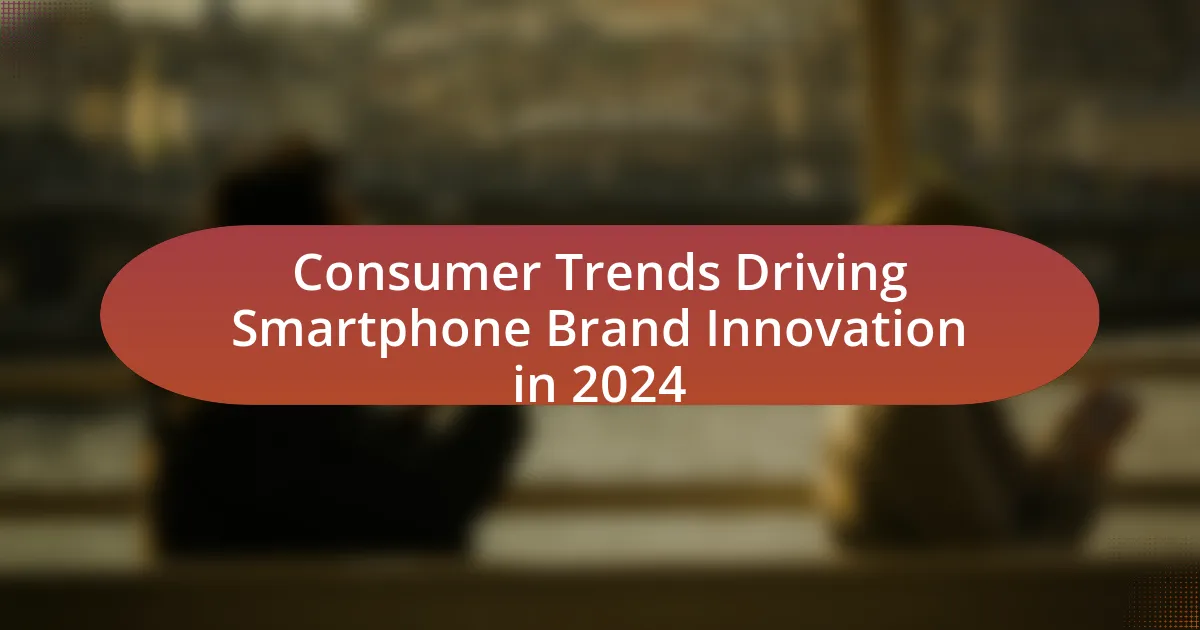The article examines the evolution of smartphone branding in a post-pandemic world, highlighting shifts towards digital connectivity, sustainability, and user-centric features. It discusses how brands like Apple and Samsung adapted their strategies to meet changing consumer behaviors, emphasizing online engagement, health-related features, and eco-friendly practices. Key trends include increased personalization, the importance of digital marketing, and the impact of supply chain disruptions on branding efforts. The article also explores the role of social media and influencer partnerships in enhancing brand visibility and consumer loyalty, while addressing the challenges and future prospects for smartphone branding in a rapidly evolving market.

What is the Evolution of Smartphone Branding in a Post-Pandemic World?
The evolution of smartphone branding in a post-pandemic world has shifted towards emphasizing digital connectivity, sustainability, and user-centric features. As consumer behavior changed during the pandemic, brands like Apple and Samsung adapted their marketing strategies to highlight remote work capabilities, enhanced camera technology for virtual interactions, and eco-friendly materials in device production. For instance, Apple reported a 66% increase in sales of its iPhone 12 series, which emphasized 5G connectivity, reflecting the growing demand for faster internet access as remote work became prevalent. Additionally, brands are increasingly focusing on personalized experiences and software ecosystems, as seen with Google’s integration of AI in its Pixel devices, catering to users’ needs for seamless digital experiences. This strategic pivot illustrates how smartphone branding has evolved to meet the new expectations of consumers in a post-pandemic landscape.
How has the pandemic influenced smartphone branding strategies?
The pandemic has significantly influenced smartphone branding strategies by accelerating the shift towards digital engagement and emphasizing health-related features. Brands have increasingly focused on online marketing channels, as physical retail spaces faced restrictions, leading to a rise in e-commerce and virtual product launches. For instance, companies like Apple and Samsung enhanced their online presence and utilized social media platforms to reach consumers directly. Additionally, the pandemic prompted brands to highlight features such as contactless payments, enhanced camera capabilities for virtual communication, and health monitoring applications, aligning their products with the evolving consumer needs during health crises. This strategic pivot is supported by a report from McKinsey, which noted that 75% of consumers have changed their shopping behavior, favoring brands that demonstrate adaptability and responsiveness to current events.
What changes in consumer behavior have emerged post-pandemic?
Post-pandemic, consumers have shifted towards increased online shopping and a preference for contactless transactions. This change is evidenced by a 2021 McKinsey report indicating that 75% of consumers have tried new shopping behaviors, with many intending to continue these habits. Additionally, there is a heightened focus on sustainability, as 60% of consumers now prioritize eco-friendly products, reflecting a significant shift in values influenced by the pandemic.
How have brands adapted their messaging during and after the pandemic?
Brands have adapted their messaging during and after the pandemic by emphasizing empathy, community support, and digital engagement. For instance, many companies shifted their focus from traditional marketing to messages that resonate with consumers’ experiences, highlighting safety, health, and social responsibility. According to a study by McKinsey, 75% of consumers expect brands to take a stand on social issues, indicating a significant shift towards purpose-driven messaging. Additionally, brands increased their digital presence, utilizing social media and online platforms to connect with consumers, as e-commerce saw a 44% growth in 2020. This adaptation reflects a broader trend where brands prioritize authenticity and relevance in their communications to align with changing consumer values.
What are the key trends in smartphone branding since the pandemic?
Key trends in smartphone branding since the pandemic include a heightened focus on sustainability, increased emphasis on digital marketing, and the rise of personalized user experiences. Brands like Apple and Samsung have prioritized eco-friendly materials and practices, responding to consumer demand for sustainable products. Digital marketing strategies have evolved, with brands leveraging social media and influencer partnerships to reach audiences more effectively; for instance, a report by Statista indicated that social media ad spending in the tech sector surged by 30% in 2021. Additionally, personalized experiences have become crucial, with companies utilizing data analytics to tailor offerings to individual preferences, enhancing customer engagement and loyalty.
How has the focus on sustainability impacted branding efforts?
The focus on sustainability has significantly transformed branding efforts by prioritizing eco-friendly practices and transparency. Brands are increasingly adopting sustainable materials and ethical production processes to appeal to environmentally conscious consumers, which has become a key differentiator in the competitive smartphone market. For instance, a 2021 survey by Deloitte found that 32% of consumers are willing to pay more for sustainable products, indicating a strong market demand for brands that align with sustainability values. This shift not only enhances brand loyalty but also improves corporate reputation, as companies that actively promote sustainability are perceived as more trustworthy and responsible.
What role does digital marketing play in current branding strategies?
Digital marketing is essential in current branding strategies as it enables brands to reach and engage their target audiences effectively through various online channels. This approach allows for precise targeting, real-time analytics, and personalized content delivery, which enhances brand visibility and customer loyalty. According to a report by Statista, digital advertising spending worldwide reached approximately $455 billion in 2021, highlighting the significant investment brands are making in digital marketing to strengthen their branding efforts. Furthermore, a survey by HubSpot found that 70% of marketers actively invest in content marketing, demonstrating the importance of digital strategies in shaping brand identity and consumer perception in today’s market.
Why is understanding smartphone branding evolution important for consumers?
Understanding smartphone branding evolution is important for consumers because it informs their purchasing decisions and helps them navigate a competitive market. As smartphone brands have shifted their strategies to adapt to consumer preferences and technological advancements, awareness of these changes enables consumers to identify which brands align with their needs, such as performance, design, and sustainability. For instance, a report by Counterpoint Research indicates that brands like Apple and Samsung have increasingly focused on eco-friendly materials and features, reflecting a growing consumer demand for sustainability. This knowledge empowers consumers to make informed choices that not only meet their personal requirements but also align with broader societal values.
How can consumers benefit from being aware of branding changes?
Consumers can benefit from being aware of branding changes by making informed purchasing decisions that align with their values and preferences. Awareness of branding changes allows consumers to identify shifts in product quality, company ethics, and market positioning, which can directly impact their satisfaction and loyalty. For instance, a study by Nielsen found that 66% of global consumers are willing to pay more for sustainable brands, indicating that awareness of branding changes related to sustainability can influence consumer choices significantly. Additionally, understanding branding changes can help consumers recognize potential risks, such as a decline in product quality or customer service, enabling them to switch to more reliable alternatives.
What implications do branding shifts have on consumer choices?
Branding shifts significantly influence consumer choices by altering perceptions of value, quality, and trust associated with products. For instance, when a smartphone brand repositions itself to emphasize sustainability, consumers increasingly favor it due to heightened awareness of environmental issues, as evidenced by a 2021 Nielsen report indicating that 73% of millennials are willing to pay more for sustainable products. Additionally, branding shifts can lead to changes in market share; for example, when Apple introduced its privacy-focused branding, it attracted consumers concerned about data security, resulting in a notable increase in user loyalty and sales. Thus, branding shifts directly impact consumer preferences and purchasing behaviors by reshaping their understanding of product attributes and brand identity.

What are the specific branding strategies adopted by smartphone companies?
Smartphone companies adopt several specific branding strategies, including differentiation, emotional branding, and influencer partnerships. Differentiation involves creating unique product features, such as advanced camera technology or innovative design, to stand out in a crowded market; for instance, Apple emphasizes its ecosystem integration and user experience. Emotional branding focuses on building a connection with consumers through storytelling and lifestyle marketing, as seen in Samsung’s campaigns that highlight creativity and innovation. Influencer partnerships leverage social media personalities to reach target demographics effectively, with brands like OnePlus collaborating with tech influencers to enhance credibility and visibility. These strategies are supported by market research indicating that emotional connections and unique product offerings significantly influence consumer purchasing decisions.
How do smartphone brands differentiate themselves in a crowded market?
Smartphone brands differentiate themselves in a crowded market through unique features, branding strategies, and targeted marketing. For instance, companies like Apple emphasize ecosystem integration and premium design, while brands like Xiaomi focus on offering high specifications at competitive prices. Additionally, brands utilize distinct marketing campaigns that resonate with specific demographics, such as Samsung’s focus on innovation and cutting-edge technology. According to a 2022 report by Counterpoint Research, brands that effectively communicate their unique value propositions can capture significant market share, demonstrating the importance of differentiation in consumer choice.
What unique selling propositions are being emphasized by leading brands?
Leading brands in the smartphone market emphasize unique selling propositions such as advanced camera technology, sustainability, and enhanced user experience. For instance, Apple highlights its superior camera capabilities and ecosystem integration, which appeals to consumers seeking high-quality photography and seamless device connectivity. Samsung focuses on sustainability by promoting eco-friendly materials and energy-efficient designs, addressing the growing consumer demand for environmentally responsible products. Additionally, brands like Google emphasize user experience through software optimization and AI features, enhancing functionality and personalization. These propositions are supported by market research indicating that consumers prioritize innovation, environmental impact, and usability in their purchasing decisions.
How do collaborations and partnerships enhance brand visibility?
Collaborations and partnerships enhance brand visibility by leveraging the combined audiences and resources of the involved entities. When two or more brands collaborate, they can reach a broader demographic, as each brand introduces its audience to the other, effectively doubling the potential reach. For instance, a partnership between a smartphone manufacturer and a popular app developer can result in co-marketing efforts that highlight the unique features of the smartphone while promoting the app, thus increasing visibility for both parties. Research indicates that brands that engage in strategic partnerships can see up to a 30% increase in brand awareness, as they benefit from shared marketing channels and enhanced credibility through association.
What role does social media play in smartphone branding today?
Social media plays a crucial role in smartphone branding today by serving as a primary platform for engagement, marketing, and consumer feedback. Brands utilize social media channels like Instagram, Twitter, and TikTok to showcase their products, connect with consumers, and build brand loyalty. According to a 2022 survey by Statista, 54% of consumers reported discovering new smartphone brands through social media advertisements, highlighting its effectiveness in reaching potential customers. Additionally, user-generated content and influencer partnerships on these platforms enhance brand visibility and credibility, further solidifying the impact of social media on smartphone branding in the current market landscape.
How are brands leveraging influencers to reach target audiences?
Brands are leveraging influencers to reach target audiences by utilizing their established credibility and follower engagement to promote products. Influencers create authentic content that resonates with their audience, which enhances brand visibility and trust. For instance, a study by the Digital Marketing Institute found that 49% of consumers depend on influencer recommendations when making purchasing decisions. This strategy allows brands to tap into niche markets and demographics that align with their products, effectively increasing conversion rates and brand loyalty.
What impact does user-generated content have on brand perception?
User-generated content significantly enhances brand perception by fostering authenticity and trust among consumers. Research indicates that 79% of people say user-generated content highly impacts their purchasing decisions, as it provides relatable and genuine insights into a brand’s offerings. This content often showcases real-life experiences, which can lead to increased engagement and a positive emotional connection with the brand. Furthermore, brands that actively incorporate user-generated content into their marketing strategies can see a 20% increase in engagement rates, demonstrating its effectiveness in shaping consumer attitudes and perceptions.

What challenges do smartphone brands face in the post-pandemic landscape?
Smartphone brands face significant challenges in the post-pandemic landscape, primarily due to supply chain disruptions and changing consumer behavior. The COVID-19 pandemic caused widespread shortages of components, such as semiconductors, which continue to affect production capabilities. According to a report by the Semiconductor Industry Association, global semiconductor sales reached $555 billion in 2021, but ongoing shortages have led to delays and increased costs for smartphone manufacturers. Additionally, consumer preferences have shifted towards more affordable devices and sustainable practices, compelling brands to adapt their strategies. Research from Deloitte indicates that 60% of consumers are now more concerned about sustainability, pushing brands to innovate in eco-friendly materials and production processes. These factors create a complex environment for smartphone brands as they navigate recovery and growth in a transformed market.
How has supply chain disruption affected branding efforts?
Supply chain disruption has significantly impacted branding efforts by limiting product availability and altering consumer perceptions. Brands have faced challenges in maintaining consistent messaging and product launches due to delays and shortages, which can lead to diminished brand loyalty and trust. For instance, a survey by McKinsey & Company indicated that 75% of consumers reported being frustrated with brands that could not deliver products on time during supply chain issues. This disruption has forced brands to adapt their strategies, focusing on transparency and communication to rebuild consumer confidence.
What strategies are brands employing to mitigate supply chain issues?
Brands are employing several strategies to mitigate supply chain issues, including diversifying suppliers, increasing inventory levels, and investing in technology for better supply chain visibility. Diversifying suppliers helps brands reduce dependency on a single source, thereby minimizing risks associated with disruptions. For instance, companies like Apple have expanded their supplier base across different regions to avoid bottlenecks. Increasing inventory levels allows brands to buffer against delays, as seen with Samsung, which has ramped up stockpiling of critical components. Additionally, investing in technology, such as AI and data analytics, enhances supply chain visibility, enabling brands to anticipate disruptions and respond proactively. This multifaceted approach is essential for maintaining operational resilience in a volatile market.
How do economic factors influence branding decisions?
Economic factors significantly influence branding decisions by shaping consumer purchasing power and market demand. For instance, during economic downturns, consumers tend to prioritize essential goods over luxury items, prompting brands to adjust their messaging and positioning to emphasize value and affordability. According to a 2021 McKinsey report, 75% of consumers changed their shopping behavior during the pandemic, leading brands to focus on cost-effective solutions and essential features in their products. Additionally, inflation rates can affect production costs, compelling brands to either absorb costs or pass them onto consumers, which directly impacts brand perception and loyalty. Thus, economic conditions dictate how brands communicate their value propositions and adapt their strategies to meet shifting consumer expectations.
What are the future prospects for smartphone branding?
The future prospects for smartphone branding include increased personalization, sustainability, and integration of advanced technologies. As consumer preferences shift towards unique and tailored experiences, brands will focus on customization options that resonate with individual users. Additionally, the growing emphasis on environmental responsibility will drive brands to adopt sustainable practices, such as using eco-friendly materials and promoting recycling initiatives. Furthermore, the integration of technologies like artificial intelligence and augmented reality will enhance user engagement and create immersive brand experiences. These trends are supported by market research indicating that 70% of consumers are more likely to purchase from brands that demonstrate a commitment to sustainability, and 60% express interest in personalized products.
How might emerging technologies shape branding strategies?
Emerging technologies significantly shape branding strategies by enabling personalized customer experiences and enhancing engagement through data analytics and artificial intelligence. For instance, brands can leverage AI-driven insights to tailor marketing messages and product recommendations based on individual consumer behavior, leading to higher conversion rates. According to a 2021 McKinsey report, companies that effectively utilize data analytics can increase their marketing ROI by 15-20%. Additionally, technologies such as augmented reality (AR) allow brands to create immersive experiences, fostering deeper connections with consumers. A study by Deloitte found that 88% of consumers reported a positive experience with brands that use AR in their marketing efforts. Thus, the integration of emerging technologies into branding strategies not only improves customer engagement but also drives measurable business outcomes.
What trends should consumers watch for in smartphone branding?
Consumers should watch for the trend of sustainability in smartphone branding, as companies increasingly prioritize eco-friendly materials and practices. For instance, brands like Apple and Samsung are incorporating recycled materials into their devices and packaging, reflecting a growing consumer demand for environmentally responsible products. Additionally, the rise of modular smartphones, which allow for easy repairs and upgrades, aligns with sustainability efforts by reducing electronic waste. This shift not only appeals to environmentally conscious consumers but also influences brand loyalty and purchasing decisions in the evolving market.
What best practices can smartphone brands adopt for effective branding?
Smartphone brands can adopt several best practices for effective branding, including creating a strong brand identity, engaging with customers through social media, and emphasizing sustainability. A strong brand identity, characterized by a unique logo, consistent messaging, and a clear value proposition, helps differentiate a brand in a competitive market. Engaging with customers on social media platforms fosters community and loyalty, as evidenced by brands like Apple and Samsung, which actively interact with their audiences. Additionally, emphasizing sustainability resonates with consumers; a 2021 survey by Deloitte found that 32% of consumers are willing to pay more for sustainable products, highlighting the importance of eco-friendly practices in branding strategies.
How can brands maintain authenticity in their messaging?
Brands can maintain authenticity in their messaging by ensuring transparency and aligning their values with those of their target audience. This involves openly communicating their practices, such as sourcing materials ethically and supporting social causes, which resonates with consumers who prioritize corporate responsibility. For instance, a study by the Harvard Business Review found that 64% of consumers want brands to connect with them on a personal level, emphasizing the importance of genuine engagement. By consistently reflecting their core values in marketing campaigns and fostering two-way communication with customers, brands can build trust and loyalty, ultimately enhancing their authenticity.
What strategies can enhance customer loyalty in smartphone branding?
To enhance customer loyalty in smartphone branding, companies should implement personalized marketing strategies, foster community engagement, and ensure consistent product quality. Personalized marketing, such as targeted promotions based on user preferences, has been shown to increase customer retention rates by up to 20%. Engaging customers through social media platforms and brand communities can create a sense of belonging, which is crucial for loyalty; studies indicate that brands with active communities see a 30% increase in customer loyalty. Additionally, maintaining high product quality and offering reliable customer service are fundamental, as 70% of consumers cite product reliability as a key factor in their loyalty to a brand.




